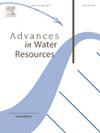Pore-scale study on solute dispersion in the aqueous phase within unsaturated porous media
IF 4.2
2区 环境科学与生态学
Q1 WATER RESOURCES
引用次数: 0
Abstract
Solute dispersion in the aqueous phase within unsaturated porous media has critical implications to various natural and engineered systems, such as nutrient and contaminant transport in the vadose zone. This work developed pore-scale lattice Boltzmann (LB) modeling to simulate water-air multiphase flow and solute transport in the aqueous phase, which unraveled the role of the water saturation and Peclet (Pe) number on solute dispersivity in unsaturated three-dimensional porous media. The Pe number and water saturation influenced the solute concentration profile along the longitudinal direction in a coupled manner. Under a low Pe number, the solute concentration profile approximately followed the classic Gaussian distribution regardless of the water saturation. Under a high Pe number, the solute concentration profile became skewed and the role of the water saturation was noticeable. Under a moderate water saturation, a significant portion of the solute particles were trapped at the trailing edge, leading to the non-Fickian transport behavior. In contrast, with a high water saturation, the enhanced water connectivity in the pore space mitigated the trapping of solute particles at the trailing edge, leading to the classic Fickian dispersion. This study also showed the non-monotonic dependence of longitudinal dispersivity on the water saturation, which was caused by a competing process between pore water connectivity and flow field heterogeneity. The pore-scale simulation confirmed that the dispersivity is not a constant but depends on the Pe number nonlinearly. Therefore, there is a complicated coupling between the dispersivity, water saturation, and Pe number for multiphase flows in porous media. This study developed a six-parameter empirical model to account for the role of the water saturation and Pe number on the longitudinal dispersivity in unsaturated flows. This empirical model can be used to predict the solute dispersion coefficient in unsaturated porous media, which is critical to large-scale contaminant transport modeling.
非饱和多孔介质中溶质水相分散的孔隙尺度研究
在非饱和多孔介质中,溶质在水相中的分散对各种自然和工程系统,如渗透带中的营养物质和污染物的运输具有重要意义。本文建立了孔尺度晶格玻尔兹曼(LB)模型,模拟水-气多相流动和溶质在水相中的运移,揭示了水饱和度和Peclet (Pe)数对非饱和三维多孔介质中溶质分散性的影响。Pe数和含水饱和度对溶质浓度沿纵向分布的影响是耦合的。在低Pe数下,无论含水饱和度如何,溶质浓度分布近似服从经典高斯分布。高Pe值时,溶质浓度曲线偏斜,含水饱和度的作用明显。在中等含水饱和度下,相当一部分溶质颗粒被困在后缘,导致非菲克输运行为。相比之下,当含水饱和度较高时,孔隙空间中水的连通性增强,减轻了溶质颗粒在后缘的捕获,导致经典的菲克分散。纵向分散度对含水饱和度的非单调依赖性是由孔隙水连通性和流场非均质性的竞争过程引起的。孔隙尺度模拟证实了色散不是一个常数,而是与Pe数呈非线性关系。因此,多孔介质中多相流的分散性、含水饱和度和Pe数之间存在着复杂的耦合关系。本文建立了一个六参数的经验模型,以解释含水饱和度和Pe数对非饱和流动纵向分散性的影响。该经验模型可用于预测非饱和多孔介质中溶质弥散系数,这对大规模污染物运移建模至关重要。
本文章由计算机程序翻译,如有差异,请以英文原文为准。
求助全文
约1分钟内获得全文
求助全文
来源期刊

Advances in Water Resources
环境科学-水资源
CiteScore
9.40
自引率
6.40%
发文量
171
审稿时长
36 days
期刊介绍:
Advances in Water Resources provides a forum for the presentation of fundamental scientific advances in the understanding of water resources systems. The scope of Advances in Water Resources includes any combination of theoretical, computational, and experimental approaches used to advance fundamental understanding of surface or subsurface water resources systems or the interaction of these systems with the atmosphere, geosphere, biosphere, and human societies. Manuscripts involving case studies that do not attempt to reach broader conclusions, research on engineering design, applied hydraulics, or water quality and treatment, as well as applications of existing knowledge that do not advance fundamental understanding of hydrological processes, are not appropriate for Advances in Water Resources.
Examples of appropriate topical areas that will be considered include the following:
• Surface and subsurface hydrology
• Hydrometeorology
• Environmental fluid dynamics
• Ecohydrology and ecohydrodynamics
• Multiphase transport phenomena in porous media
• Fluid flow and species transport and reaction processes
 求助内容:
求助内容: 应助结果提醒方式:
应助结果提醒方式:


